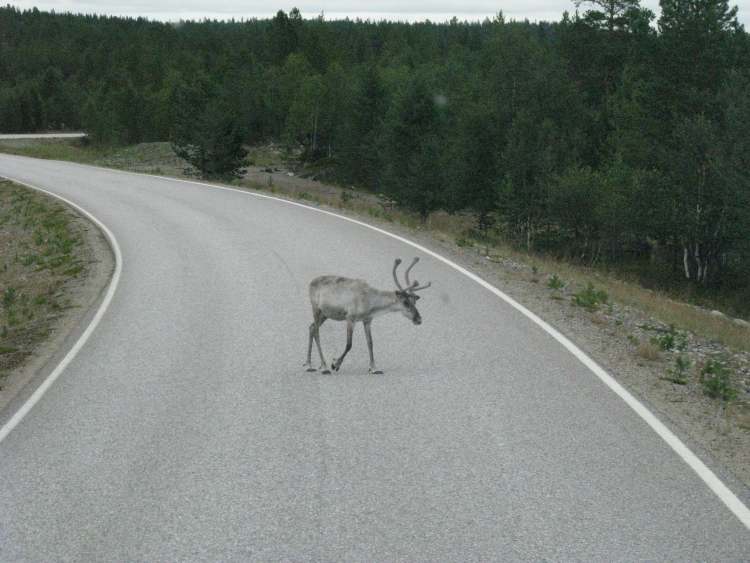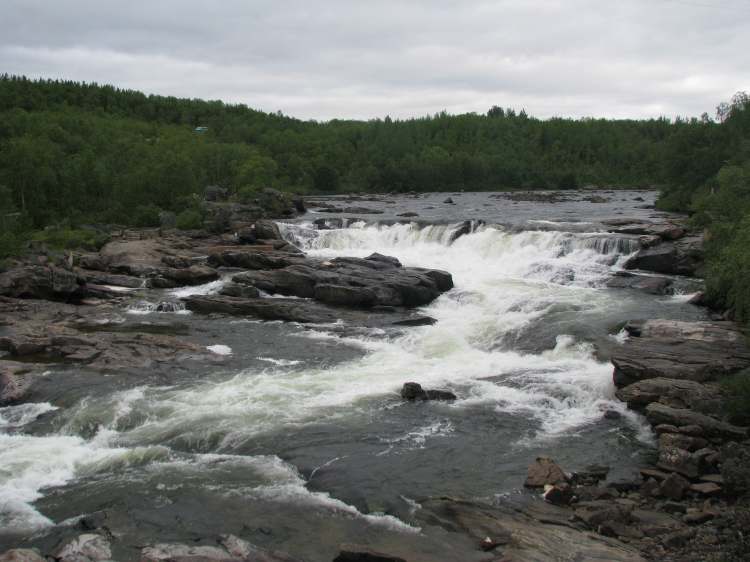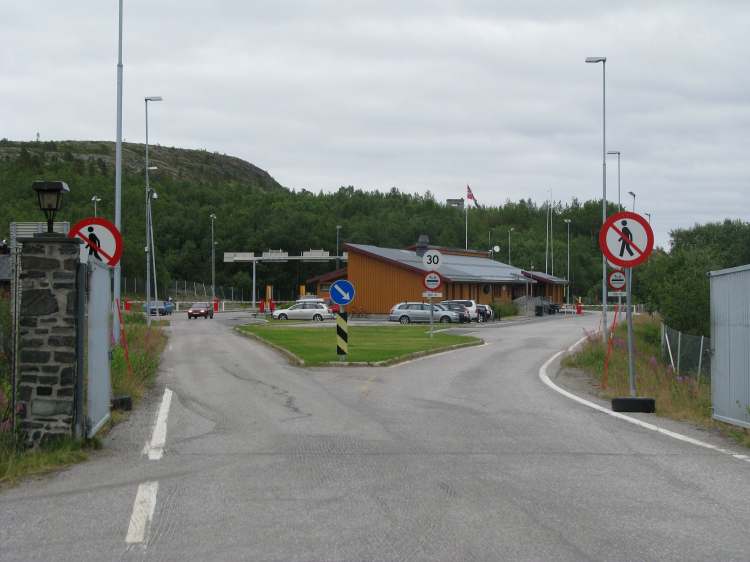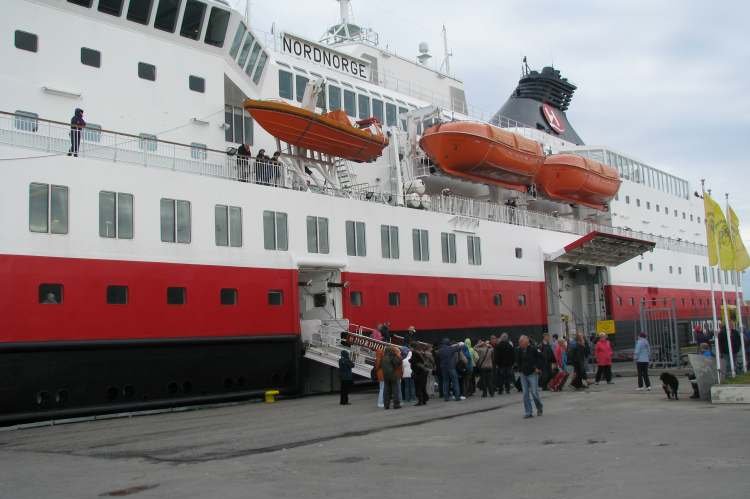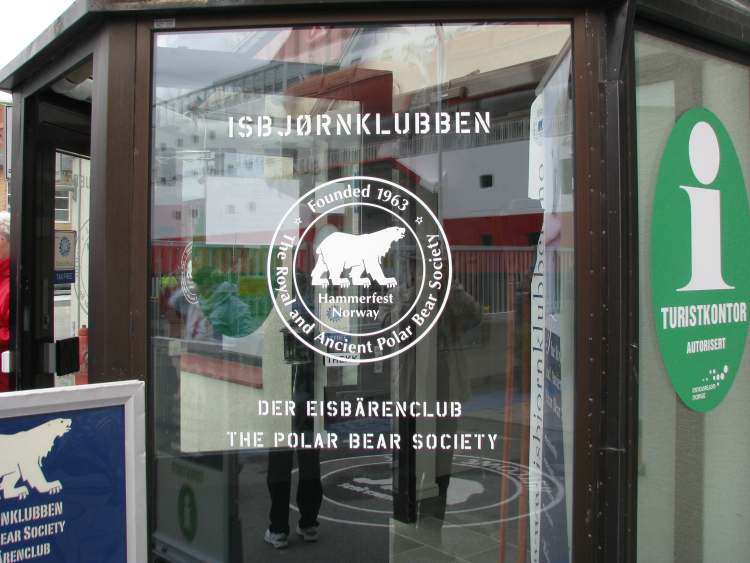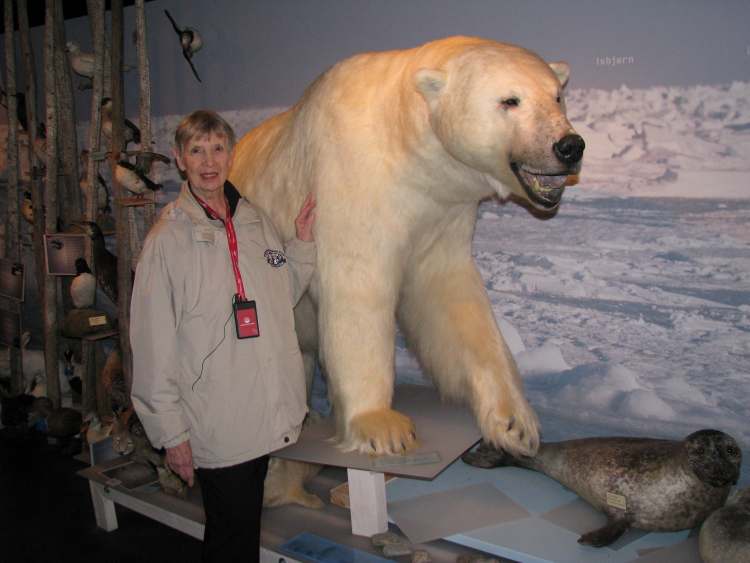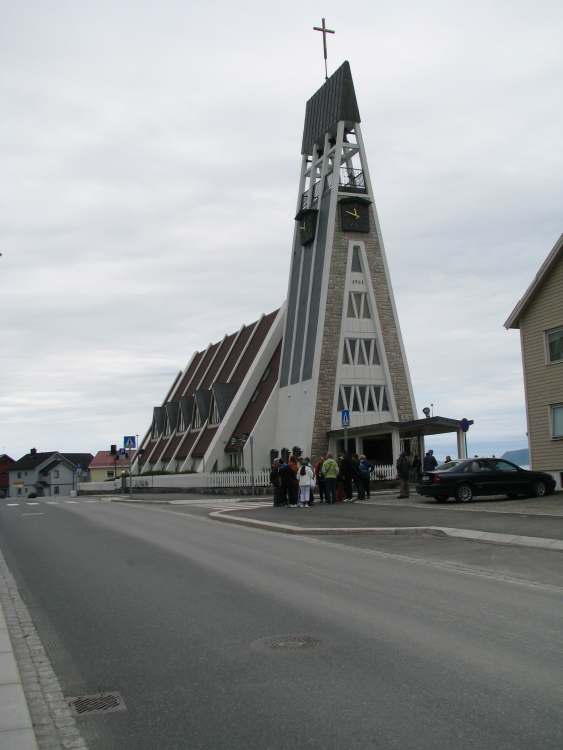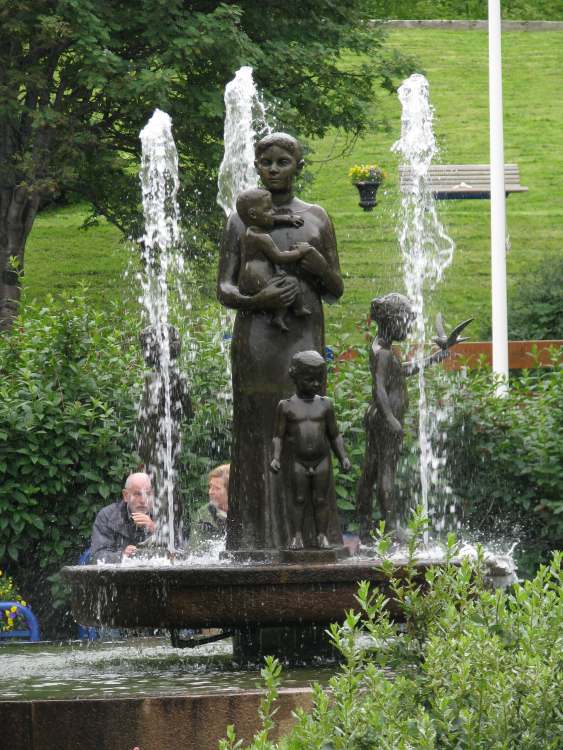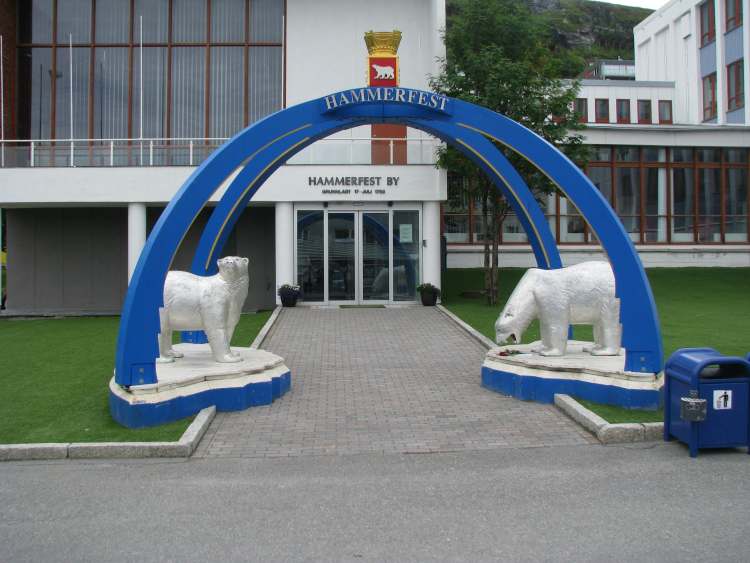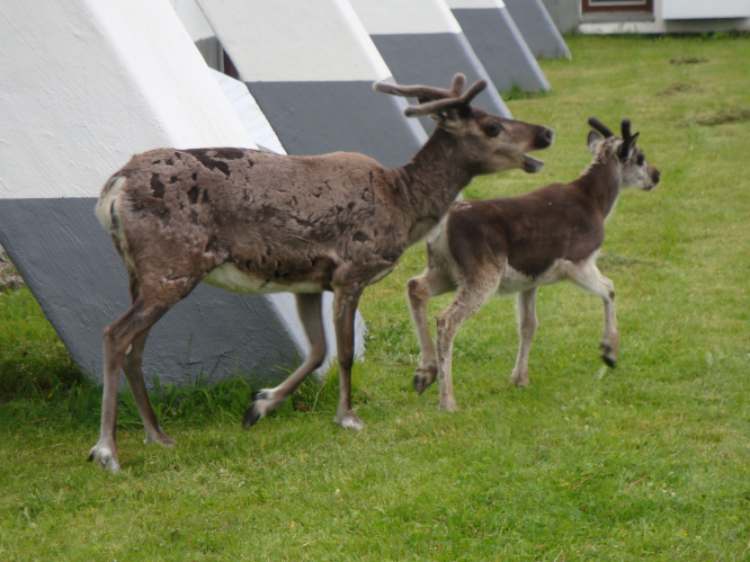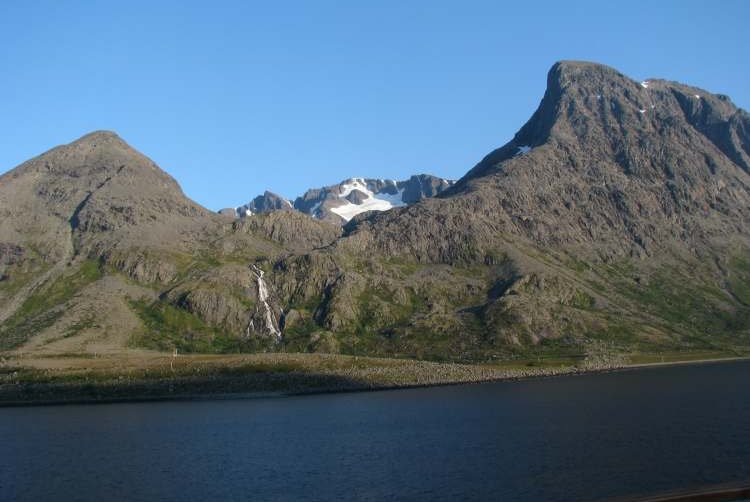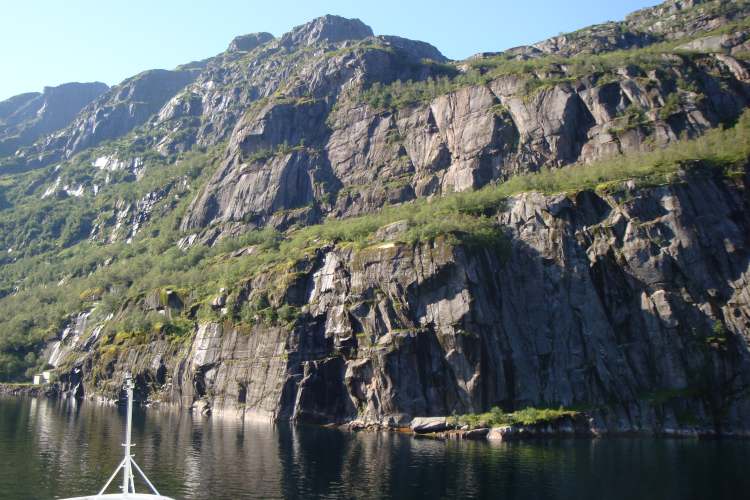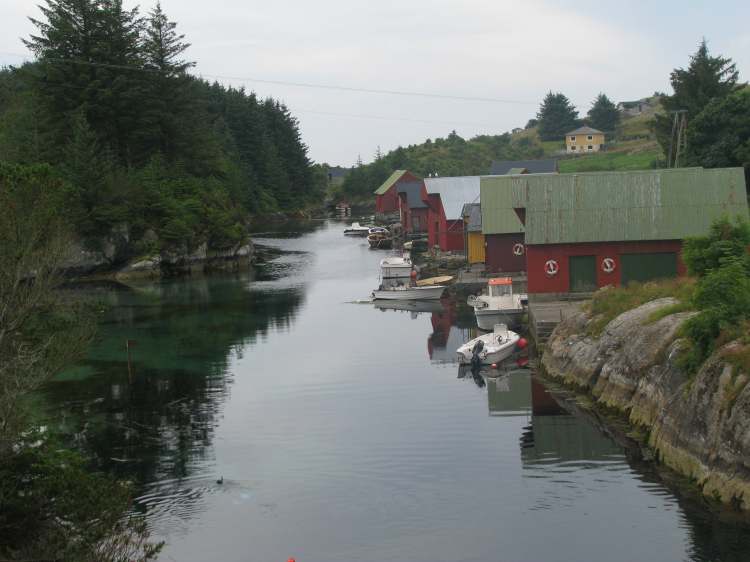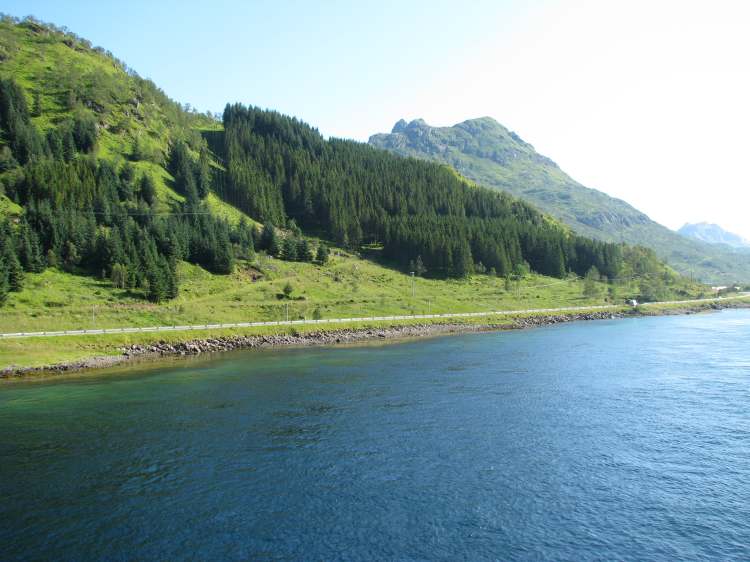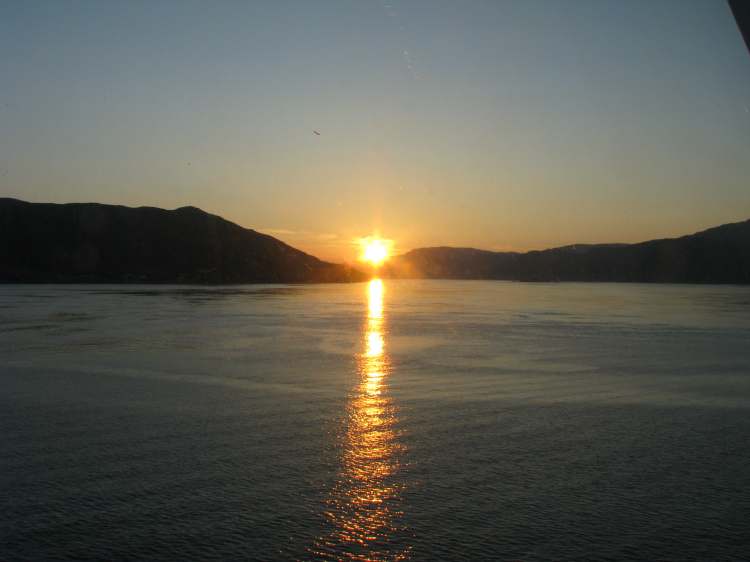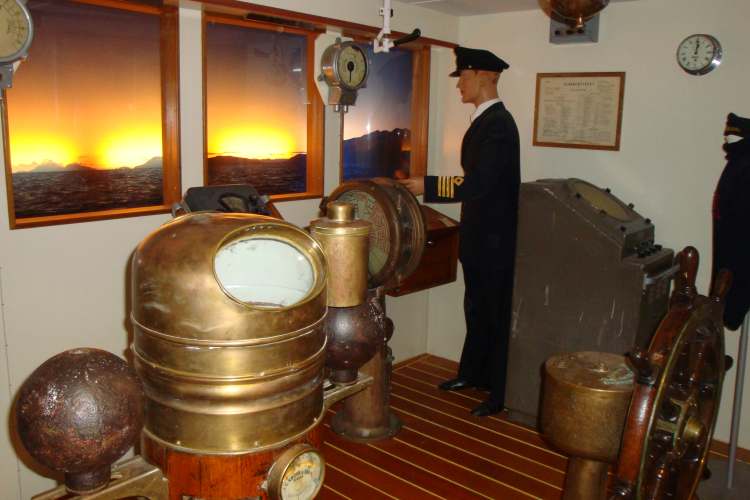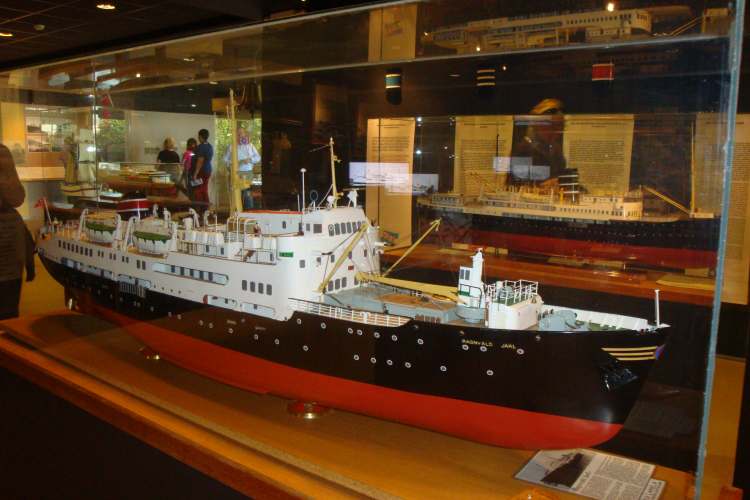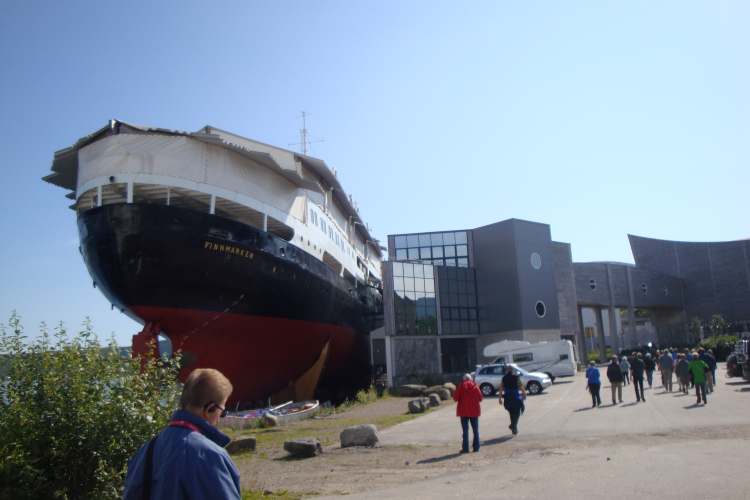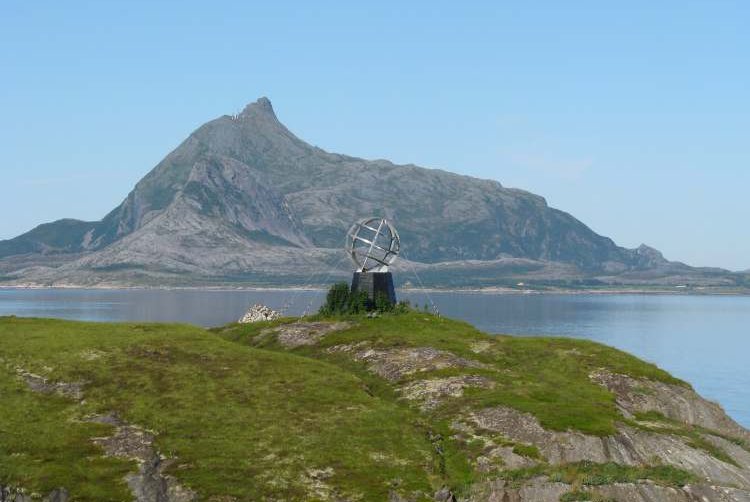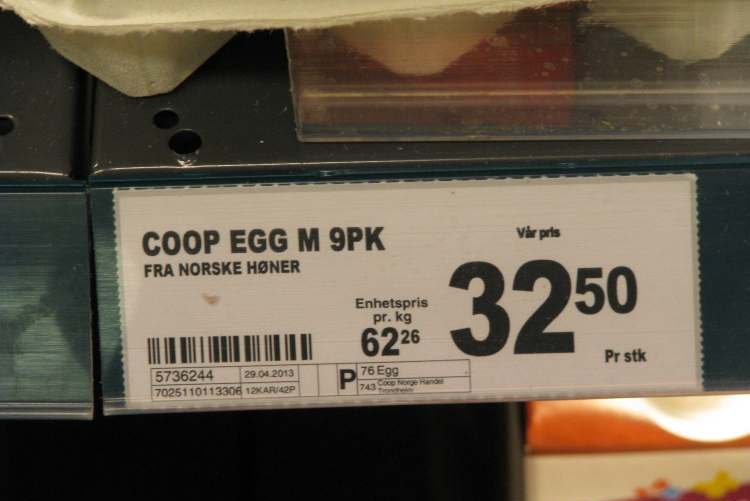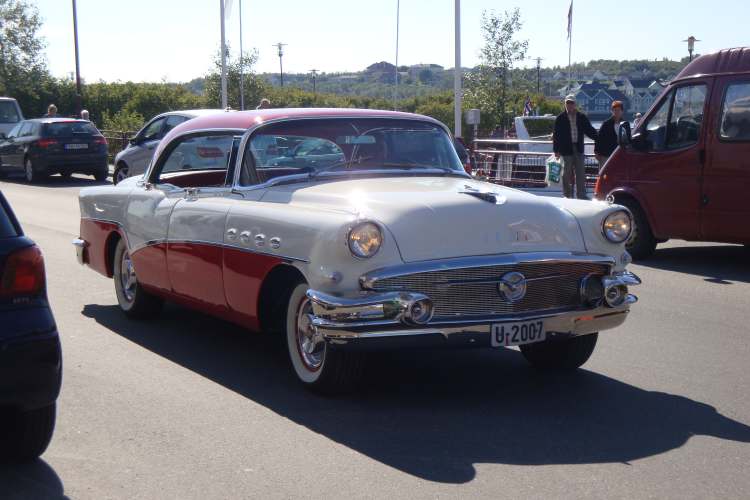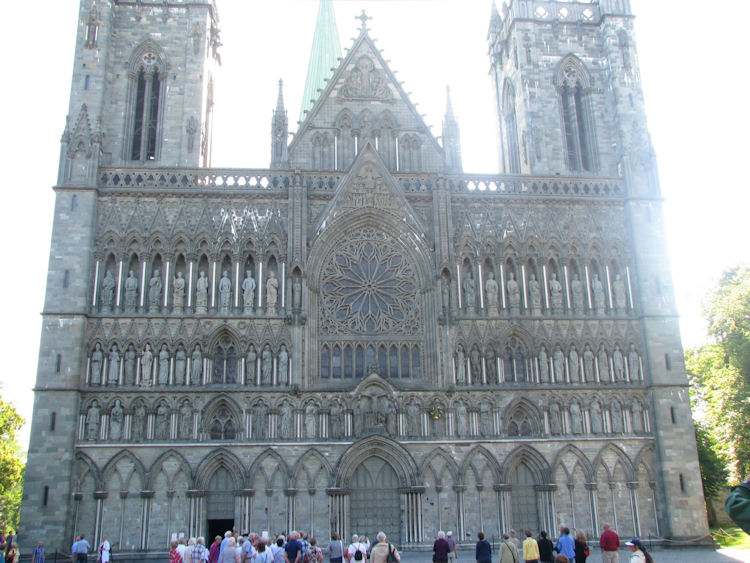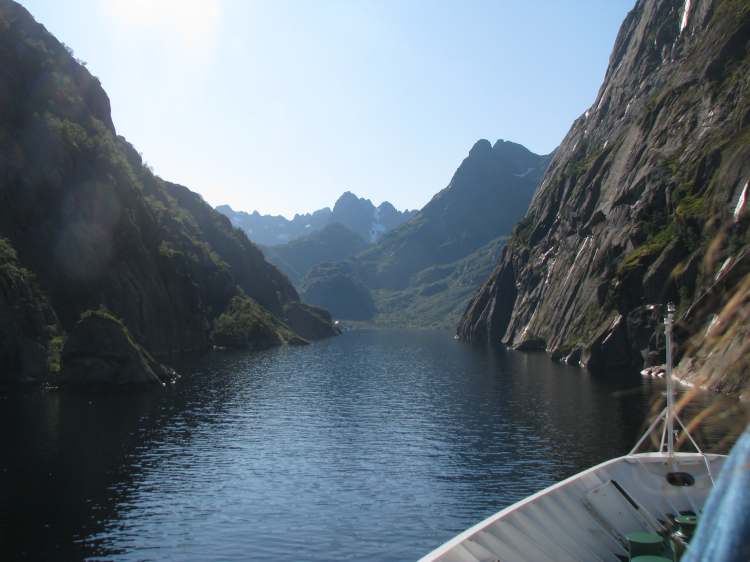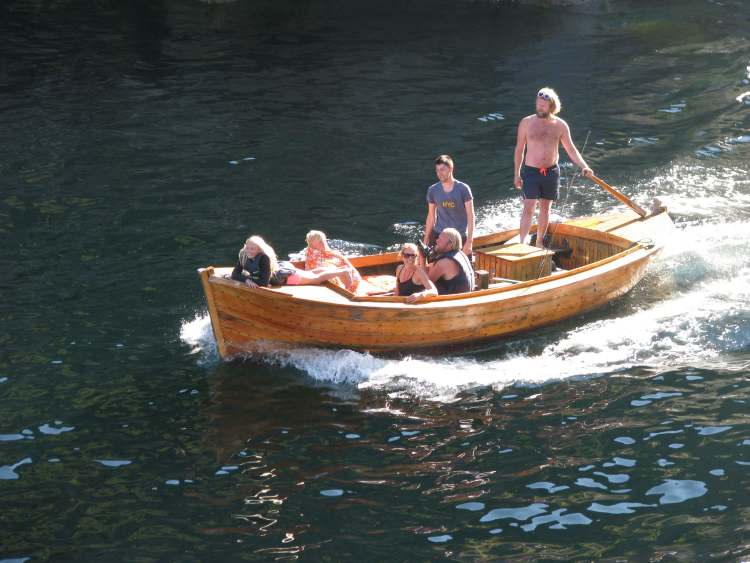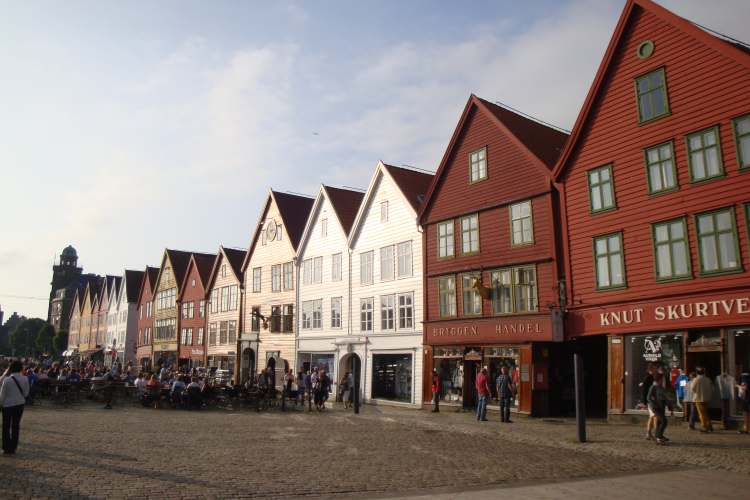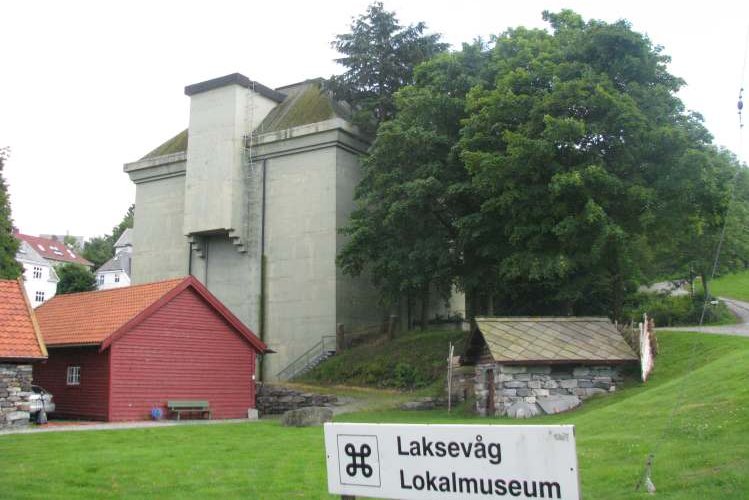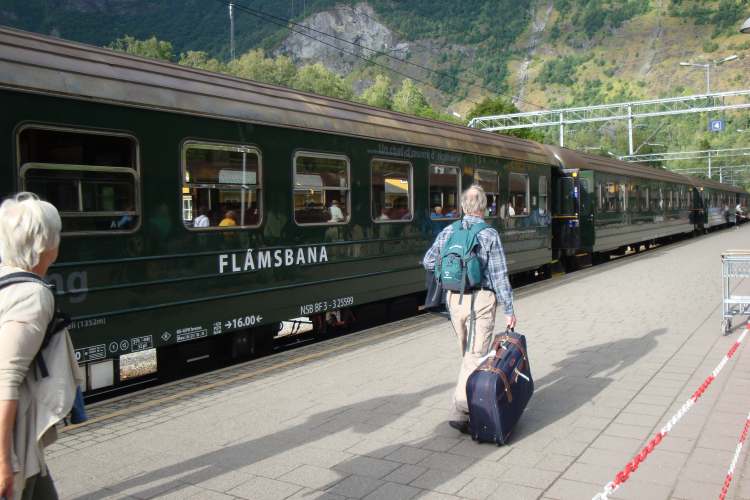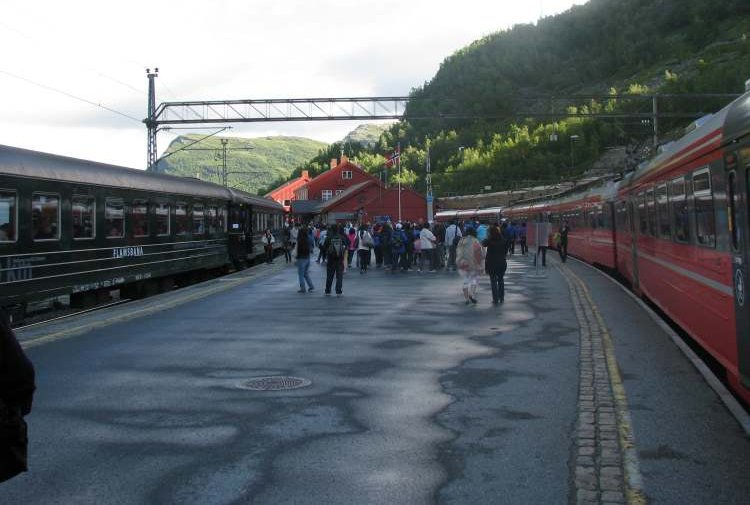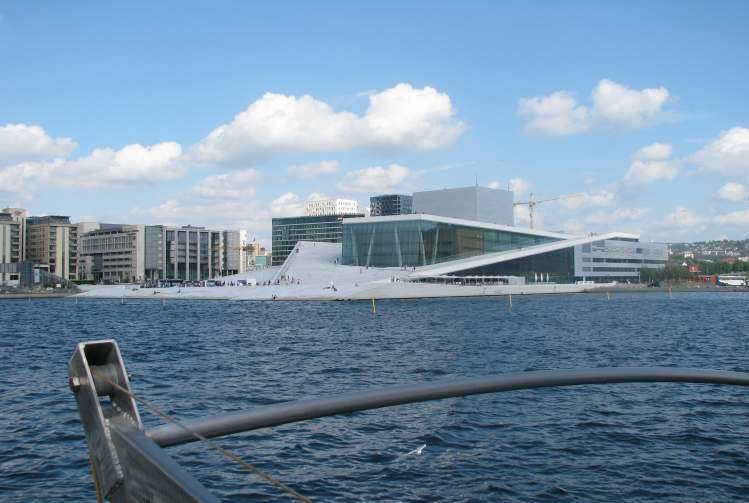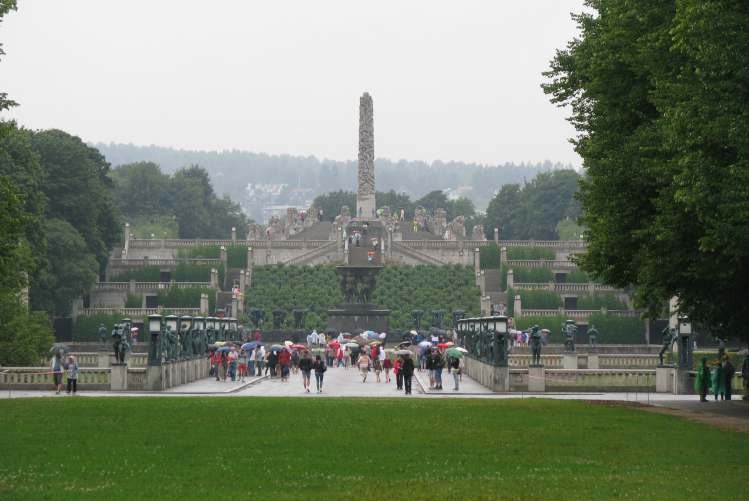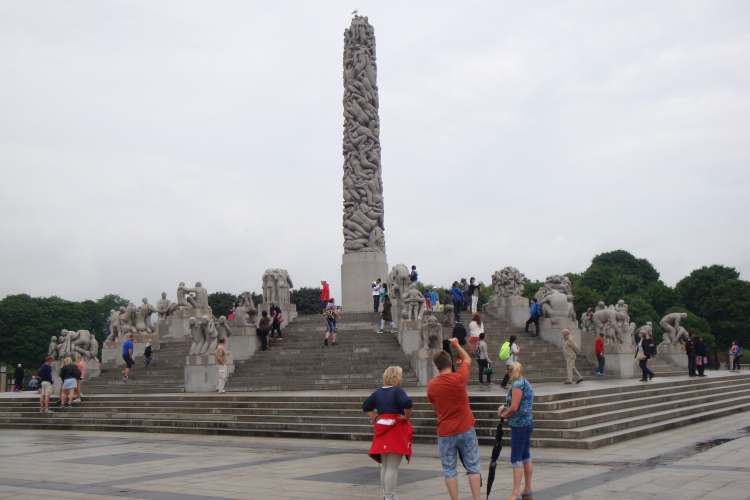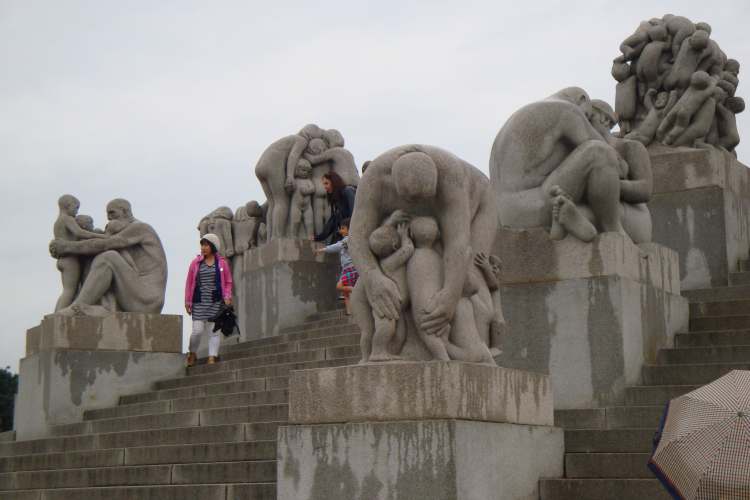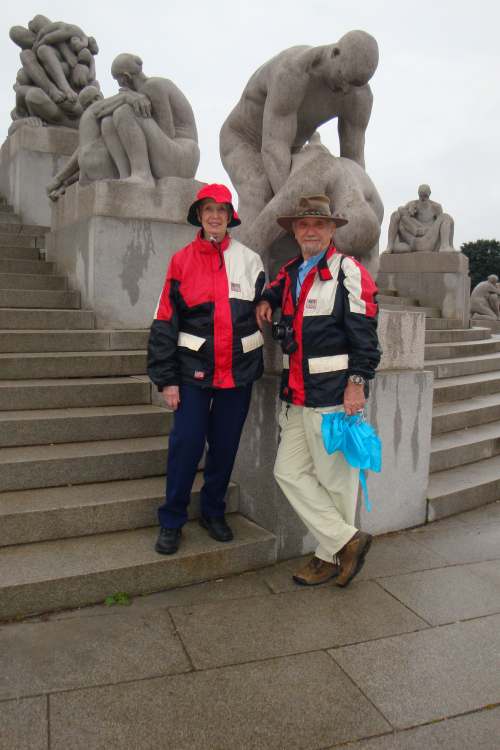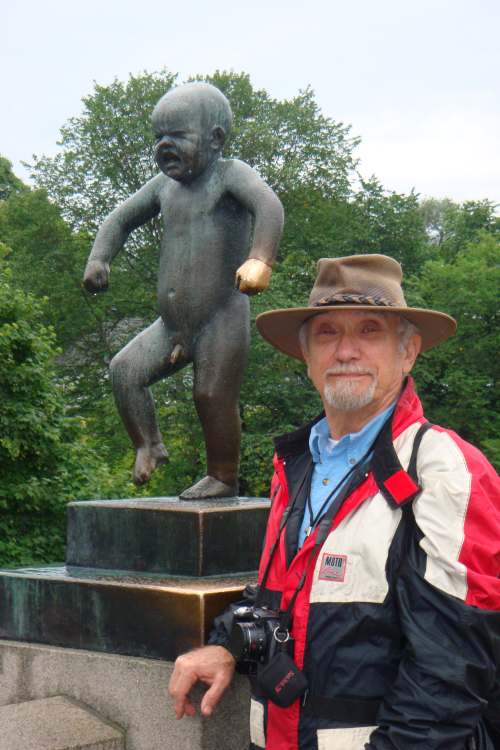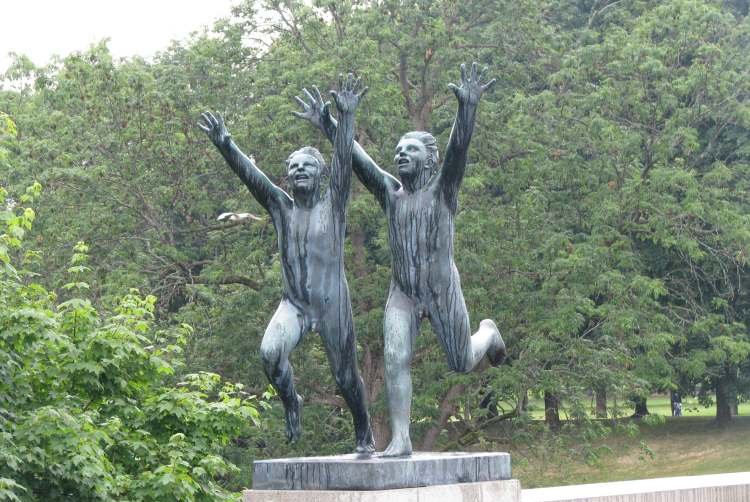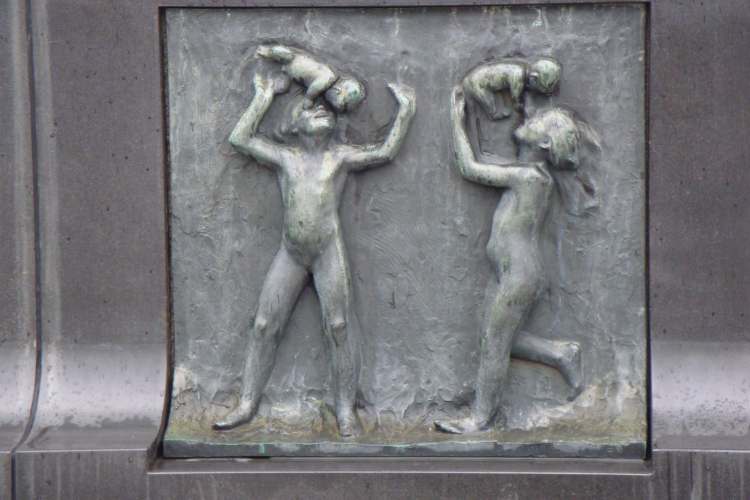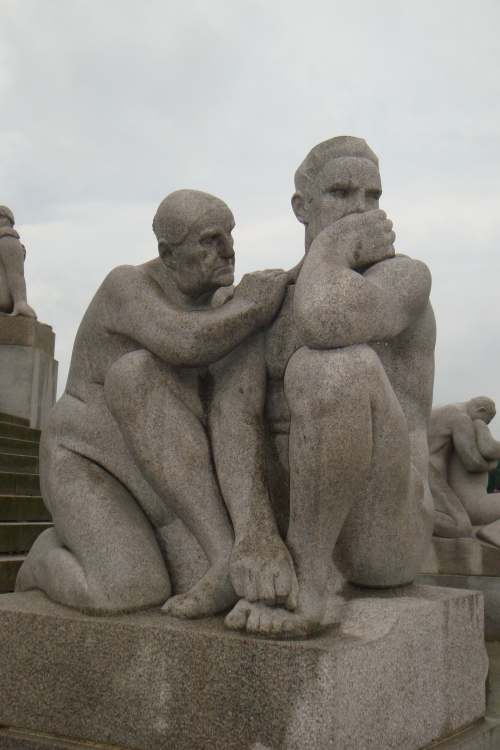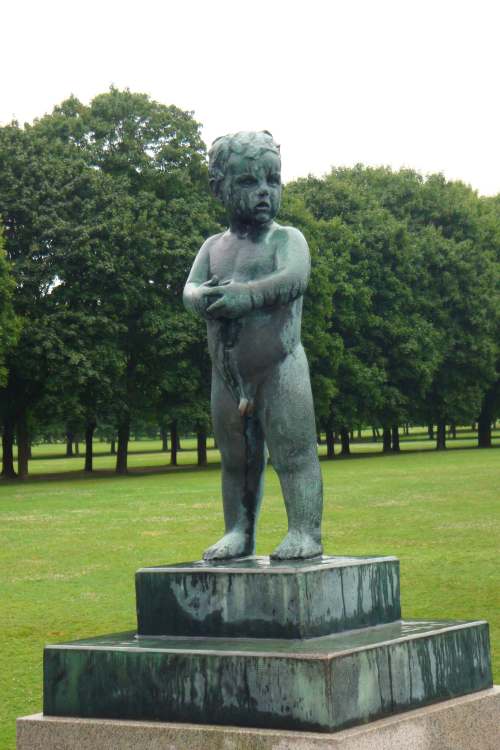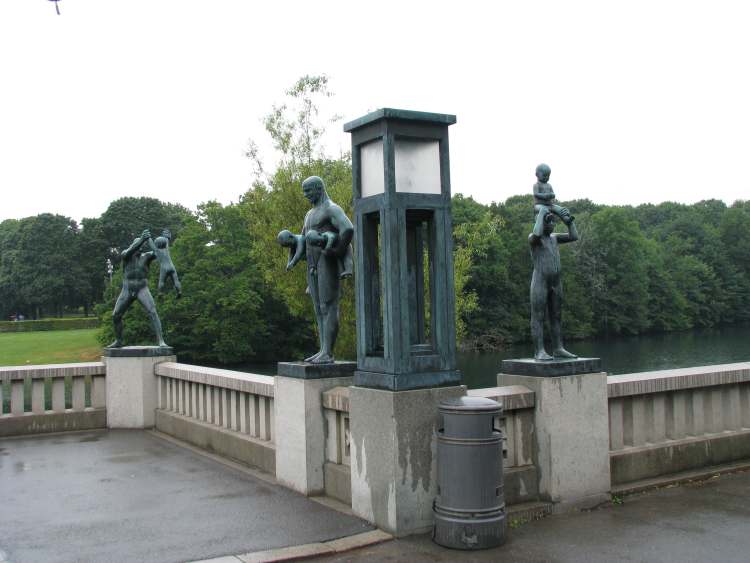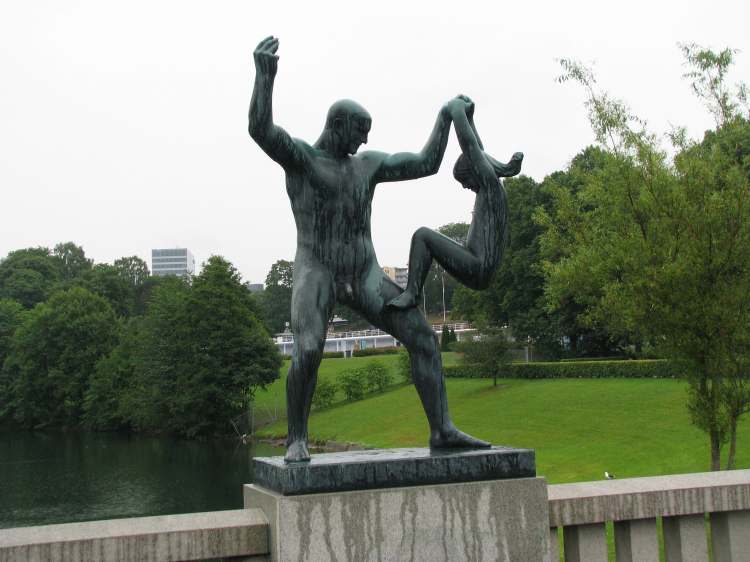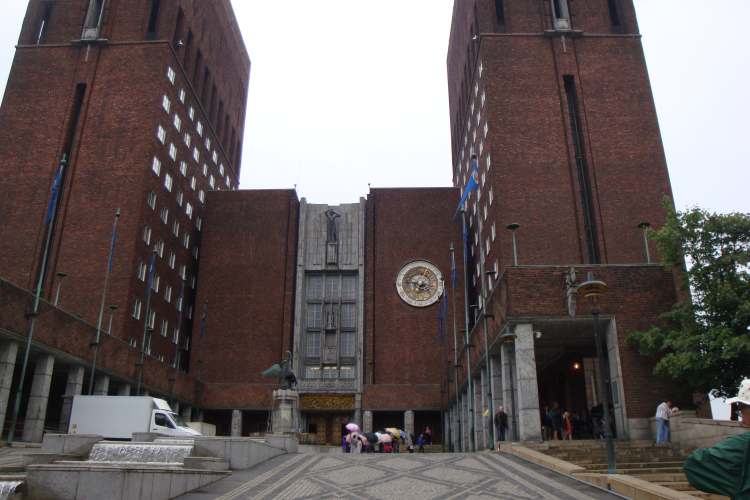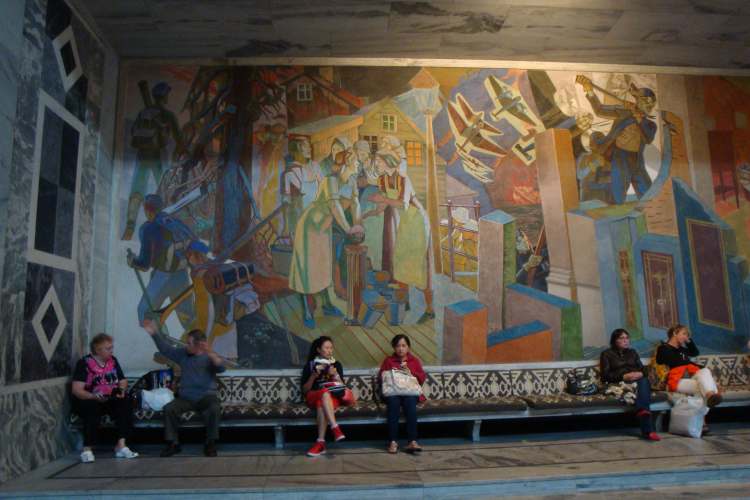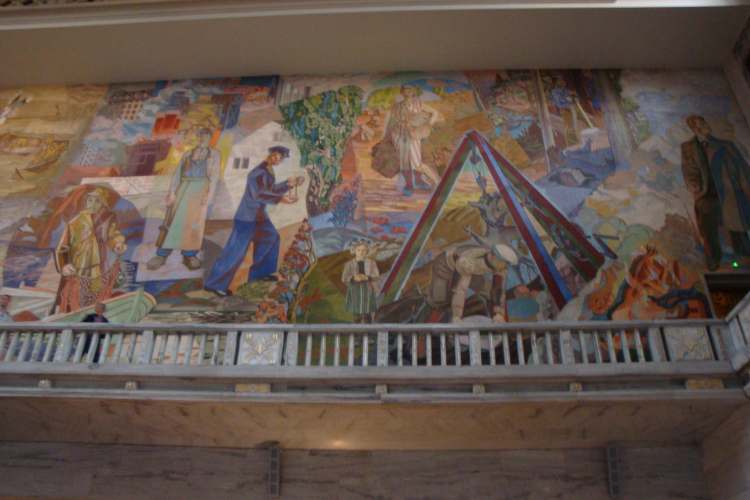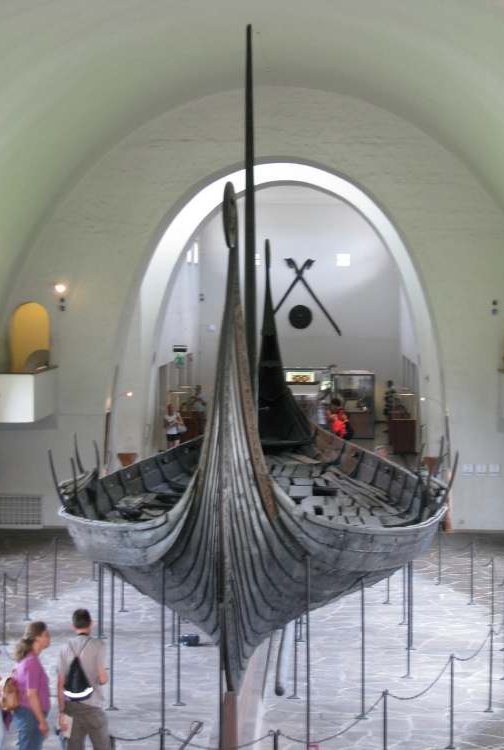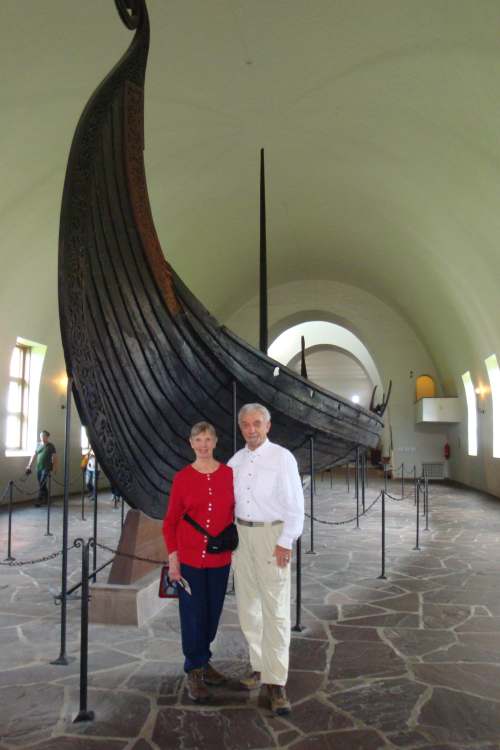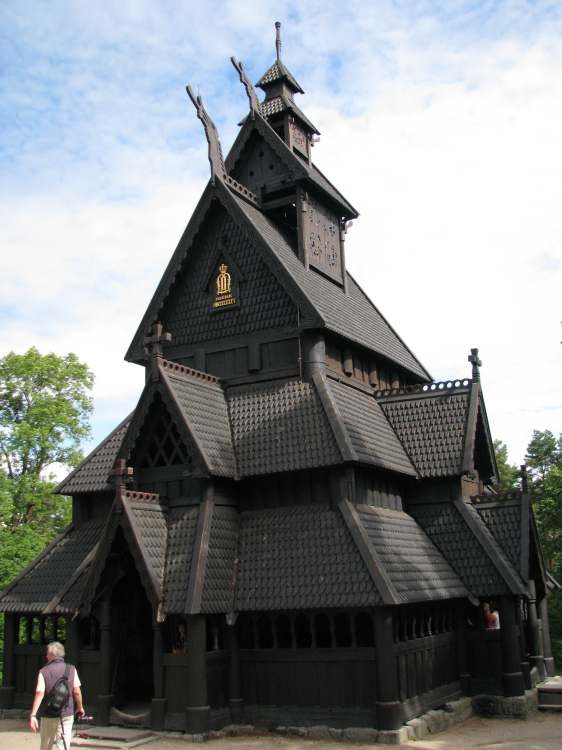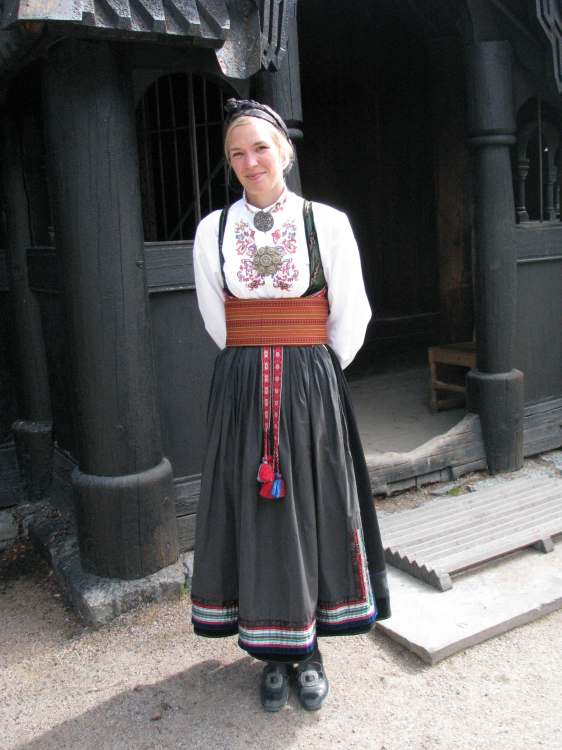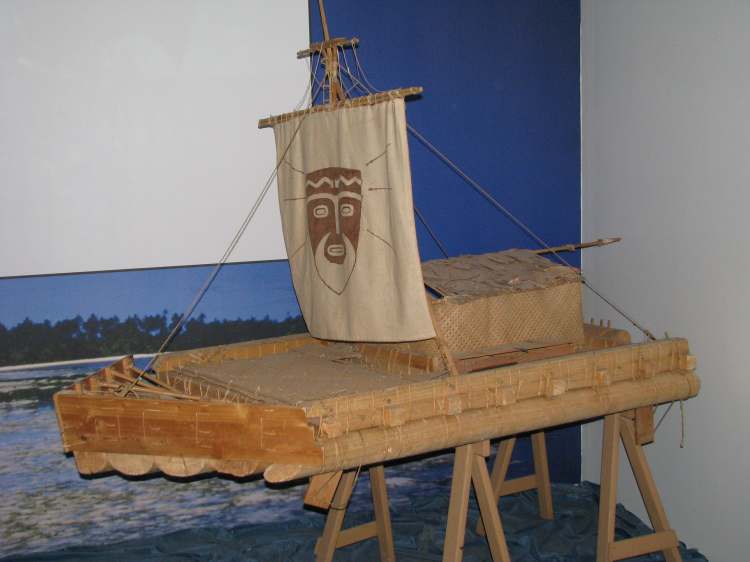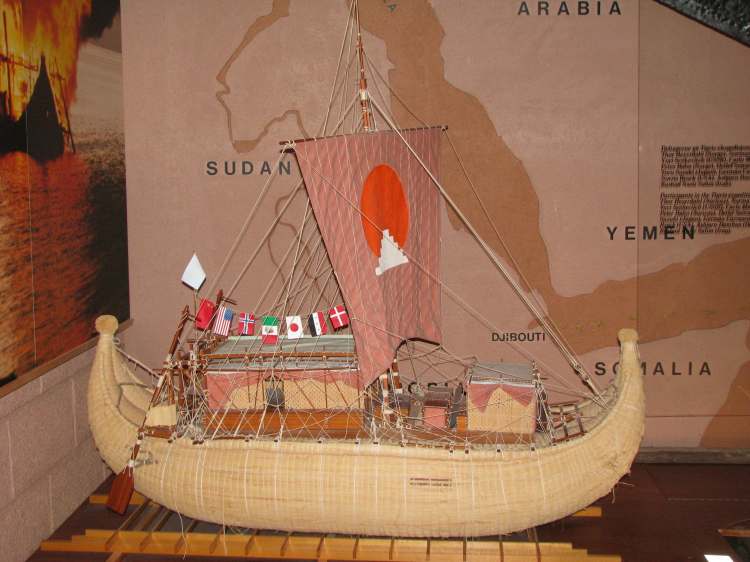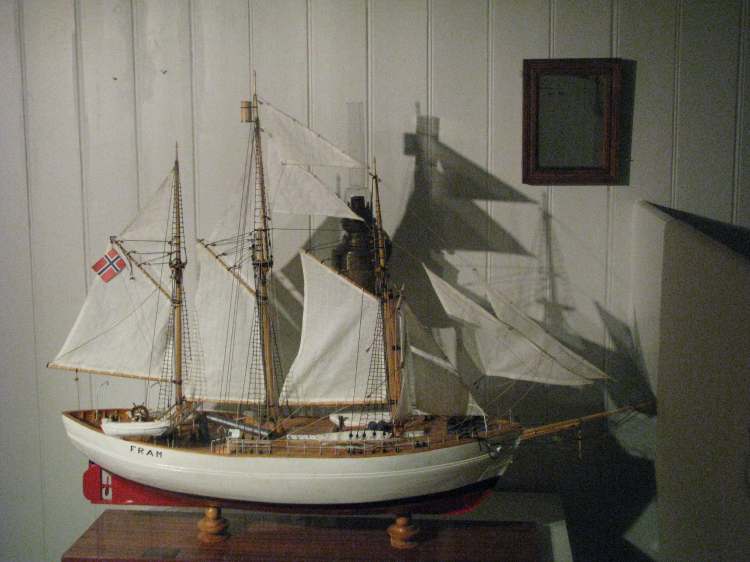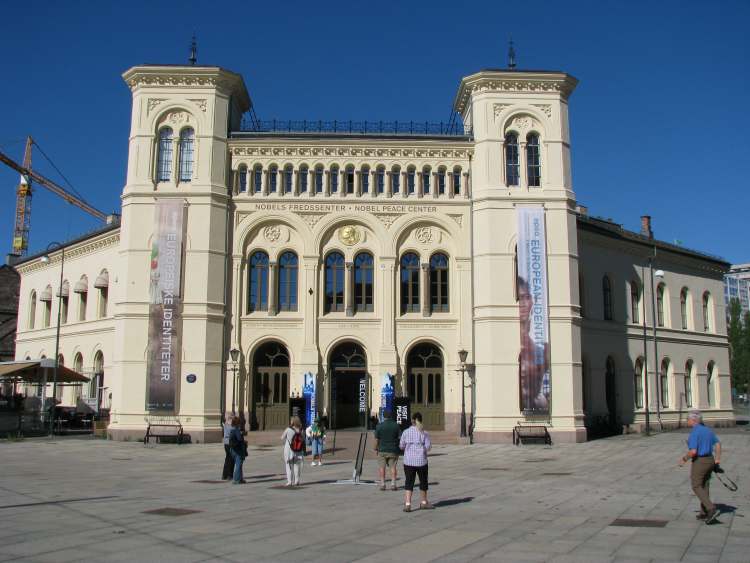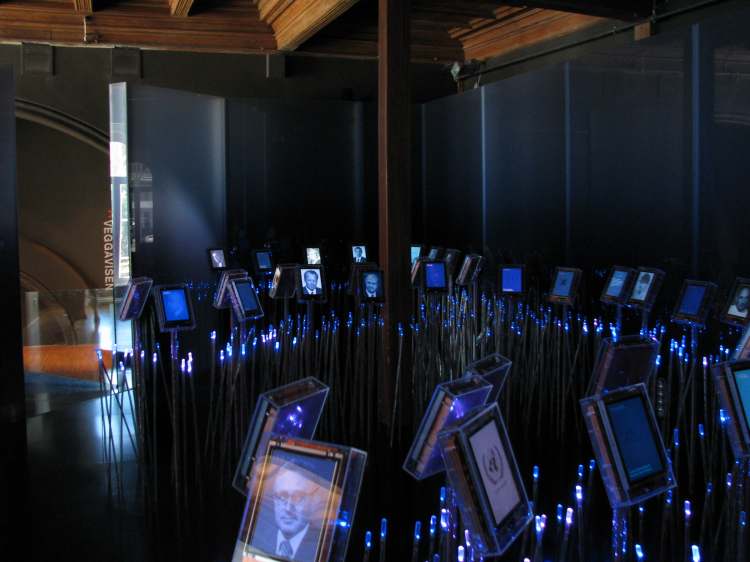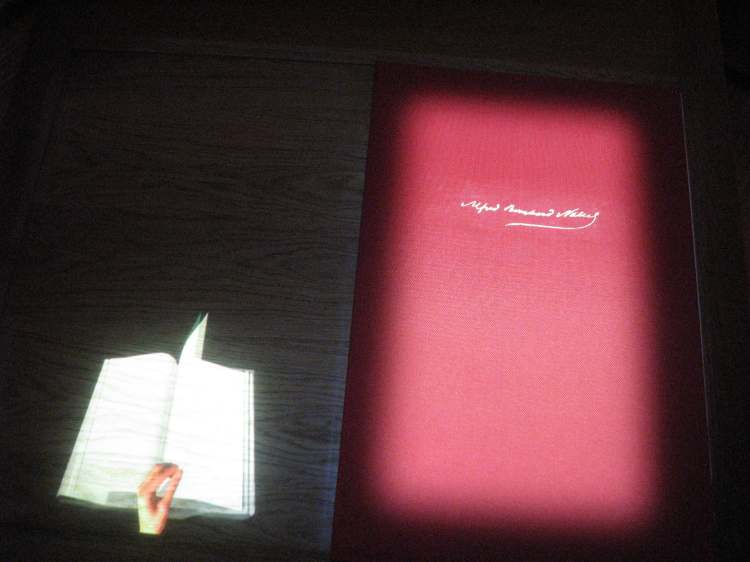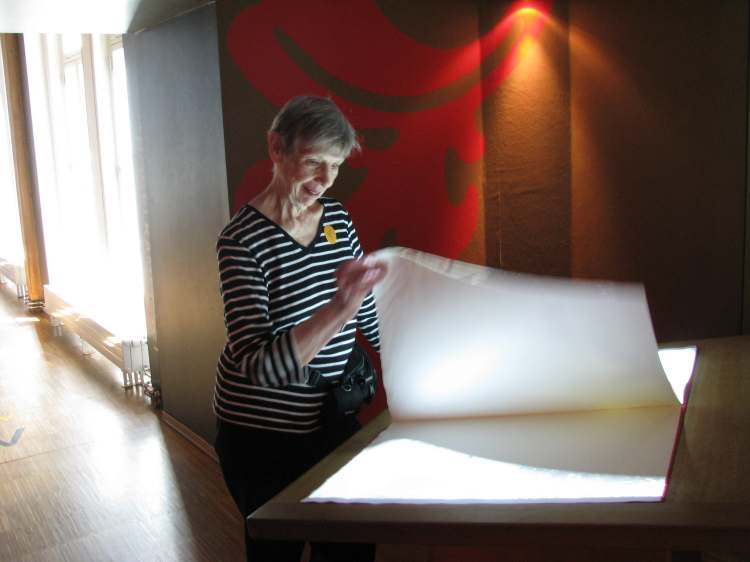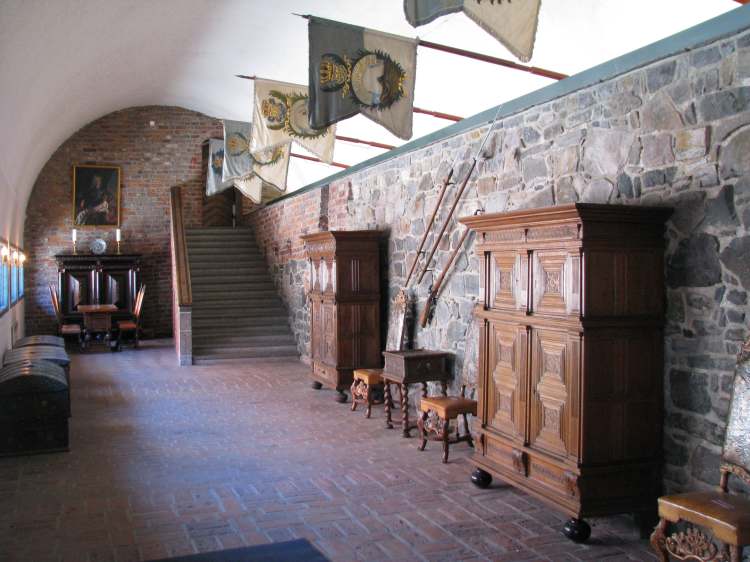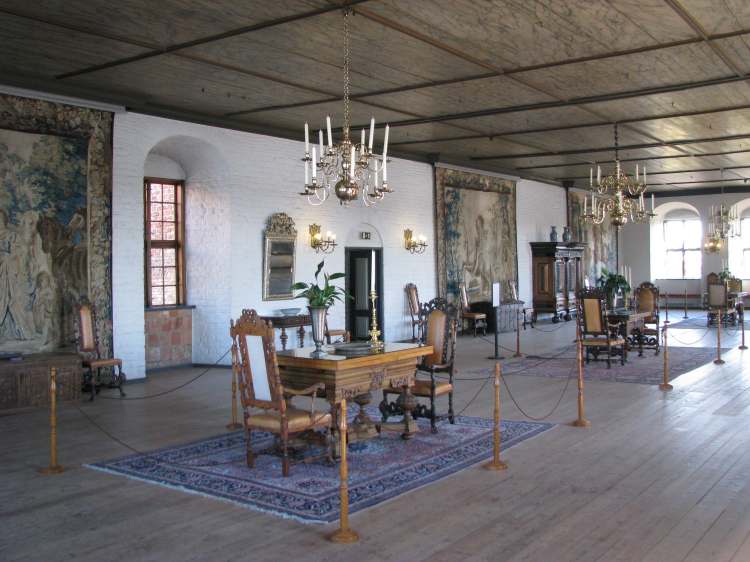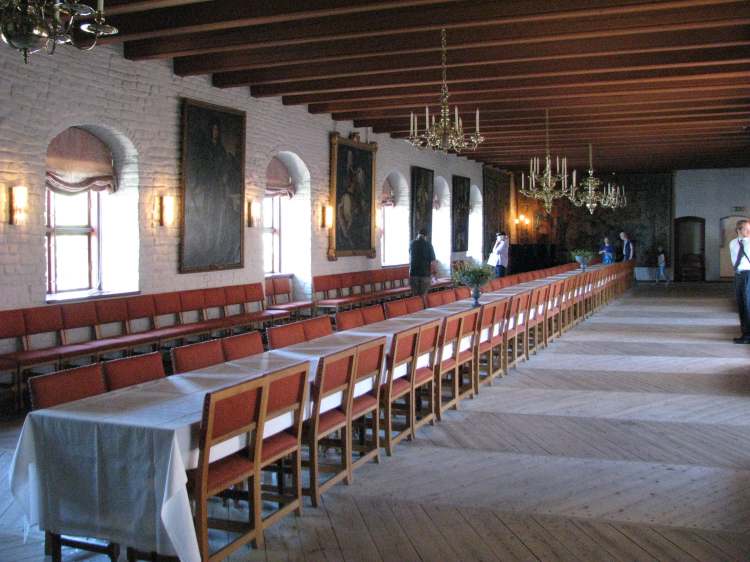Norway--2013
Diane Smith
22 Jul: Today we drove north into Norway (the Norwegians call it Norge--pronounced with a hard g). Our destination was Kirkenes where we boarded our ship for the 5-day, 1490-mile cruise along the Norwegian coastline. Reindeer are plentiful, and they are ever-present on and near the highway. Along the way we made a stop at Skolkefossen--an attractive cascade that the salmon have to climb as they make their way up river--, and we made a brief stop to see the border crossing into Russia.
We'll be traveling on what they call the Hurtigruten which translates roughly to Express Route. The MS Nordnorge is one of eleven similar ships that continuously circulate in both directions from port to port along the coastline. In addition to overnight and day passengers, these ships carry goods, mail, etc., and they make many stops day and night. In some respects it's like the system of ferries known as the Alaskan Marine Highway that shuttle between Seward, AK and Bellingham, WA; it's just a few ticks higher on the amenities scale
23 Jul: Today we took a short walk around Hammerfest. At a bit over 70 deg 39 min North, Hammerfest claims to be the northernmost city in the world, but that all depends on your definition of city. It is home to The Royal and Ancient Polar Bear Society, and the polar bear is a prominent motif throughout the town. A fountain in a small park depicts a common theme that we found in nearly every coastal town, a mother with children waiting for a fisherman to come home from the sea. The lawn at the modern-design Lutheran church attracts reindeer that help keep the place looking trim..
The scenery along the coast has been amazing--lots of beautiful views and interesting villages in and along the many fjords. The land along the coast is mostly granite (think Stone Mountain, GA) with some moss, gorse in several colors, and trees on some of them. It's mind blowing that we were far north of most of Canada, but it wasn't cold, and the waterways don't freeze during the winter. This time of year it is always daylight; so, there are few visual clues telling the time. I had to look at the clock to tell if it's time to get up, eat, or go to bed. As we approached Tromso, we finally were able to see the midnight sun which 'til now had been hidden by overcast skies. Tromso is famous as the starting point for several expeditions exploring the Northwest Passage and the north polar region.
24 Jul: The cruise continued with visits to several small towns and fishing villages. Cod is king here, and large drying racks are frequent features in and around the fishing ports. A stop at Stokmarknes on the island of Hadsel featured a visit to the Coastal Express (Hurtigruten) Museum where the history of the Norwegian coastal steamer tradition was captured in displays, films, paintings and ship models. There was even a full-size ship on display in which you could get a feel for travel in earlier days.
25 Jul: This morning we recrossed the Arctic Circle, passing a marker on a small island in the broad Vestfjord. As we approached Sandnessjoen on the island of Alsten, we got a panoramic view of De Syv Sostre (The Seven Sisters) Mountains. Later, in Bronnoysund, we ventured ashore to enjoy the nice, warm, sunny day. A brief stroll through a local market revealed some rather startling prices. Norway is a very expensive place; you can expect to pay three to four times what we pay in the U.S. for nearly everything. A case in point, check out those eggs. At 32.50 Kroner for a nine-pack, that works out to about 72¢ per egg. On our way back to the ship, a special treat was the sighting of a beautifully restored 1956 Buick Roadmaster.

26 Jul: Today we visited one of the venues for the national sport of skijumping and Trondheim with its lovely cathedral. Another highlight for the day was a transit through the narrowest of inlets along the Trollfjord. With just 100 meters of clearance, the Captain threaded the needle perfectly while an audience on smaller vessels watched with great interest.
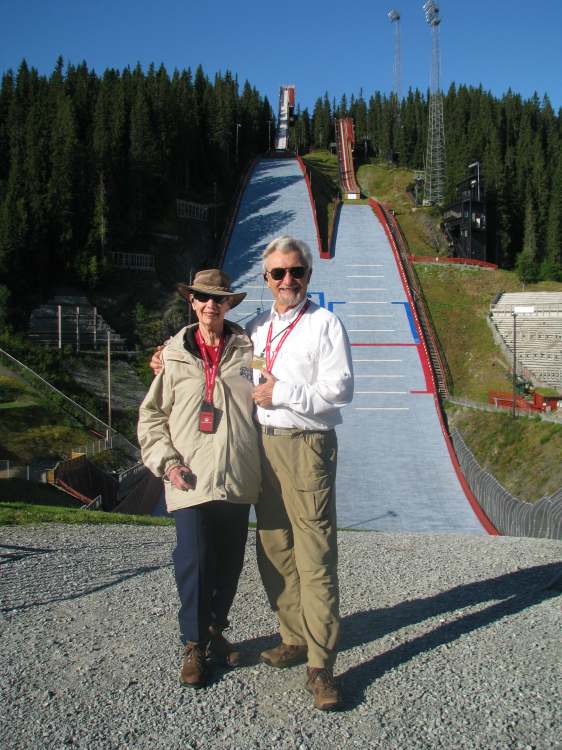
27 Jul:Our coastal voyage ended with our arrival in Bergen where we spent two nights. Bergen is a lovely place with a lot of history. A walk along the waterfront revealed some postcard worthy scenes of interesting architecture. During WW II, Bergen was home to much of the German north Atlantic Uboat fleet, and much of the town was destroyed by unsuccessful allied attempts to take out the bunkers where the boats were stored and maintained. We visited a museum housed in one of the many personnel bunkers that still stand as monuments to German engineering and building skills. A quick ride on a funicular tram allows a spectacular view of the city and port.

29 Jul: Today was a travel day as we made our way from Bergen to Oslo via what is called Norway in a Nutshell. After a zero-dark get-up, we boarded our bus for a 0530 departure. . This is a land of bridges and tunnels. Norway has more tunnels than Switzerland; they range in length from 5 meters to 24.5 kilometers.. The tunnels don't always go straight. Many of them curve several times, and all are narrow. When a large truck or bus approached us, that made for some nervous moments. But our driver, Harold, was very skilled.
After about 3 hours, Harold dropped us off at the station at the end of the Aurlandfjord where we boarded the vintage Flåm Railway for a scenic climb past spectacular peaks, valleys, and waterfalls to the Bergen Railway station at Myrdal. The Flåm Railway is one of the world's steepest railway lines on normal gauge tracks. Nearly 80% of the route is on a 55% gradient, ie: a rise of one meter per 18. The twisting tunnels and snow sheds that spiral in and around the mountains are testament to the most daring and skillful engineering in the history of Norwegian railway. At the Myrdal station we caught the next Bergen-to-Oslo train and continued our journey through the Norwegian countryside.
When we arrived at the Oslo train station, Harold was there to meet us and take us to a ferry that provided a short tour of the city's inner fjord / harbor. Just outside the train station stands the spectacular Opera House with its sloping roof that goes all the way down to the water. The harbor tour gave us a preview of some of the places we would be visiting during the next 3 days, and we got a snack consisting of a Norwegian pancake and coffee. Then it was on to the hotel and, after a brief walking tour, dinner and some rest.
Today we went to Frogner Park, a large park that included wonderful flower beds and over 200 sculptures by Gustav Vigeland. The sculptures are of people, both male and female, ranging in age from new-born infant to senior citizen. All are naked, and they display a wide range of emotional interaction and a great deal of physical 'action' frozen in time. There are also several Vigeland sculptures at various locations around the city, and all are most impressive.
We also visited the city hall where, in December, the recipients of the annual Nobel Peace Prize are honored. The walls are covered with murals depicting the country's history; very amazing. Next, we walked a few blocks to the museum displaying the works of Norway's most famous painter, Edvard Munch (pronounced Monk). Perhaps his most famous work, 'The Scream' is there. Frankly, Munch's work is generally depressing, and we opted not to see more of it at another venue
31 Jul Our morning was spent touring the Viking Museum which houses several replicas of ships and other artifacts found buried, probably at funeral sites for Viking nobles. Their helmets had metal plates to protect their noses and ears, but few, if any, actually wore helmets with horns. Their ships were impressive, and they sailed much further than most Americans know about.
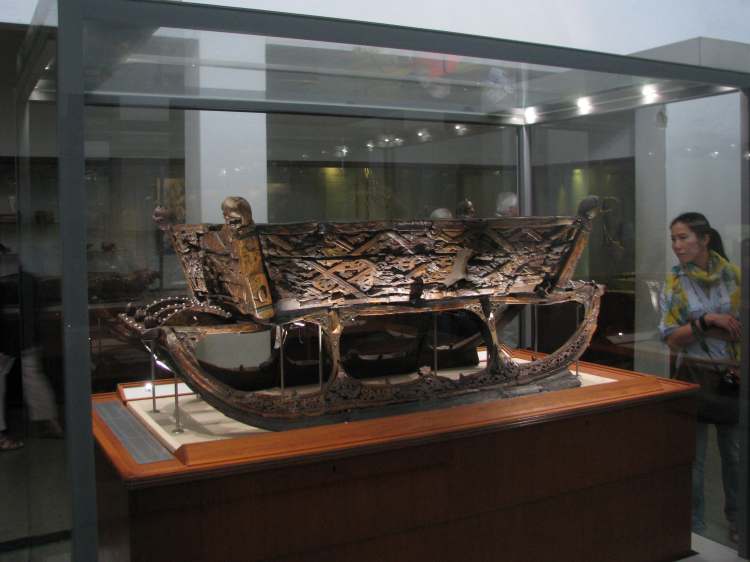
A short walk away was the Folk Museum where they have transported and reassembled homes, farm buildings, and churches from various locations throughout Norway. There were also demonstrations of traditional singing and dancing and exhibits showing historical cooking and building methods.
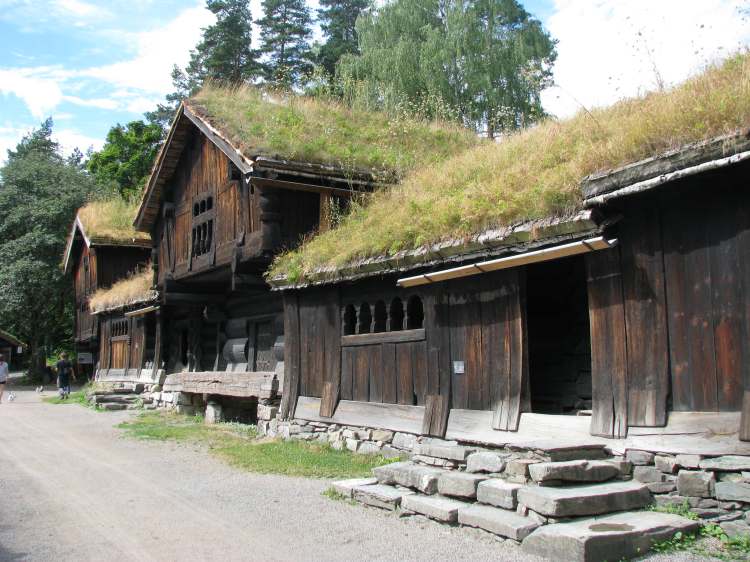
After a light lunch at the Folk Museum, we headed out to one of the islands to see Thor Heyerdahl's balsa-wood raft Kon-Tiki on which in 1947 he and his crew traveled from Peru 3,770 nautical miles to Raroia in the Tuamotus island chain in the South Pacific. Also at the Kon-Tiki Museum is the Ra II, a ship constructed out of reeds based on early Egyptian and Mesopotamian designs. It was sailed across the Atlantic from Morocco to Barbados by Heyerdahl and crew in 1970. Both voyages were made to prove that such voyages were possible in pre-Columbian times.
In the same complex is the Fram Museum which houses the polar-exploration ship Fram. This ship, of special design to withstand the crushing forces when trapped in Ice, was used during several expeditions to explore both the Arctic and the Antarctic between 1893 and 1912.
We did have a bit excitement to cap off our day. Shortly after we returned to the hotel; the fire alarm went off, and everyone had to leave the building--using the stairs and not the elevators, of course. Since we were on the 7th floor, it was a bit tedious. Wendell and Lennie (our little travel buddies) insisted they go along with us. If the building really was on fire, they didn't want to be in the room burning up. We decided to eat dinner while we waited to get back in.
We started the morning of our final day in Oslo visiting the Nobel Peace Center There are some interesting displays detailing the accomplishments of each of the Laureates to date, including the 2012 winner, the European Union. A particularly interesting feature is a large virtual book about Nobel's life. As you enter a small alcove, you see on the right side of a table a closed, red-covered book. On the left side of the table is an animated projection of a book with a hand turning the pages, prompting you to do the same with the large book on the right. When you do that, you open the cover to a series of blank pages upon which are projected images of the book's contents--a brief history of Nobel's life. The cool thing is that the motion sensors associated with the projection system can tell when you turn a page and the direction in which you turn it. So, you can browse the book, going forward and backward at will, and the projection system always displays the correct page; very clever and effective
Next, after a short walk to the other side of the waterfront, we climbed the hill up to the medieval Akershus Castle that overlooks the fjord and harbor. The castle is not unlike other such places with narrow, steep staircases; gunports and such as befits a fortress. However, it also has large banquet halls and richly appointed salons that reflect it's history as a royal residence dating back to the Danish monarchs. On the castle grounds there is also a small museum detailing the events and people involved in the Norwegian Resistance during the German occupation in WW II. Following that, we caught a tram back to the hotel to rest, pack, and attend a final meal with our tour companions and very capable tour director.

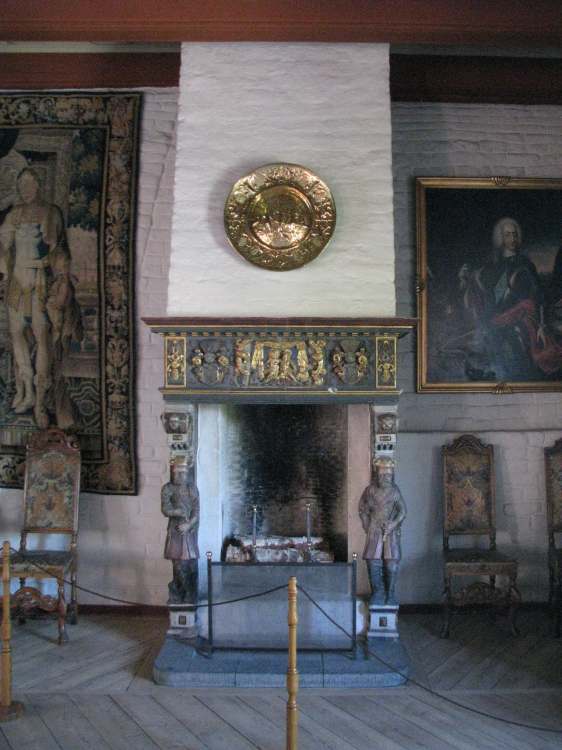
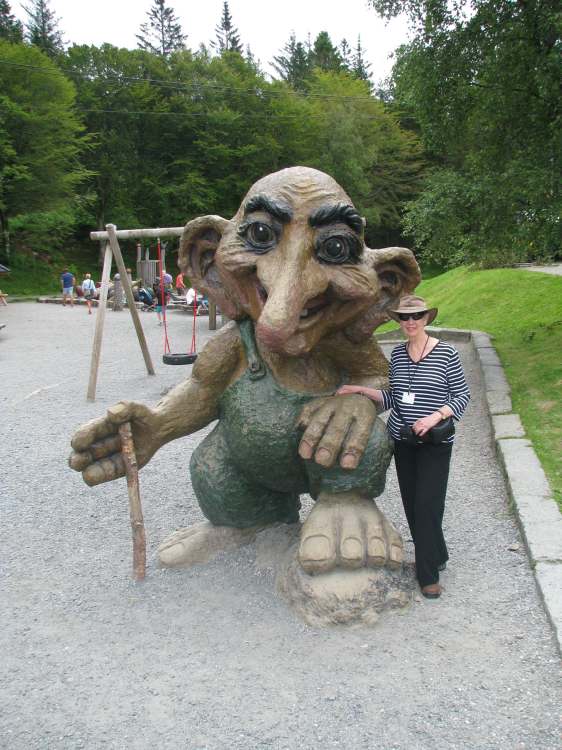
2 Aug: Heading home: When I think of Finland, I think of tall ships and reindeer; when I think of Norway, I think of beautiful, blond people; trolls; Vikings; and sun most of the time. The Nordic countries are unique, and they welcome visitors. We had a great time. As soon as I sort the 1465 pictures we took, I'll post some on Facebook and Skydrive. The food was excellent, especially the fish dishes. I'm not looking forward to weighing myself in the morning to see how much I gained. Wendell and Lennie enjoyed the trip too, and they made new friends. Our tour director, Marie, introduced them to a reindeer from Finland and a polar bear from Norway who wanted to emigrate to the U.S. We are getting quite a collection of 'little friends' who have joined us during our various travels. But I’ve made it clear to Wendell that he is the only one going with us to Spain and Portugal. Lennie only joined us on the Norway trip because, being from Iceland, that is part of his heritage, and he got to see his homeland from the airplane
